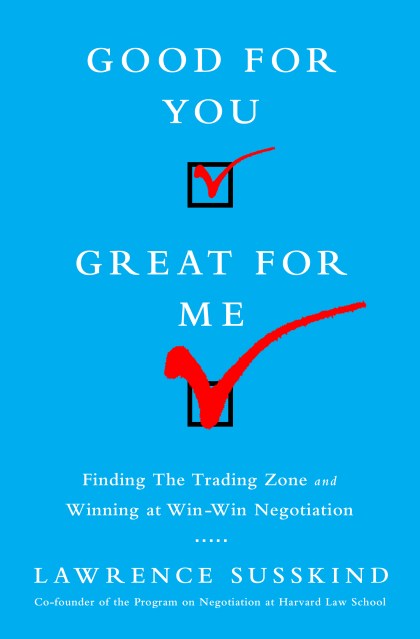Promotion
Use code MOM24 for 20% off site wide + free shipping over $45
Good for You, Great for Me
Finding the Trading Zone and Winning at Win-Win Negotiation
Contributors
Formats and Prices
Price
$14.99Price
$19.99 CADFormat
Format:
- ebook $14.99 $19.99 CAD
- Hardcover $25.99 $29.00 CAD
- Trade Paperback $16.99
This item is a preorder. Your payment method will be charged immediately, and the product is expected to ship on or around June 3, 2014. This date is subject to change due to shipping delays beyond our control.
Also available from:
“Win-win” negotiation is an appealing idea on an intellectual level: Find the best way to convince the other side to accept a mutually beneficial outcome, and then everyone gets their fair share. The reality, though, is that people want more than their fair share; they want to win. Tell your boss that you’ve concocted a deal that gets your company a piece of the pie, and the reaction is likely to be: “Maybe we need to find someone harder-nosed than you who knows how to win. We want the whole pie, not just a slice.” However, to return to an earlier era before “win-win” negotiation was in fashion and seek simply to dominate or bully opponents into submission would be a step in the wrong direction — and a public relations disaster.
By showing how to win at win-win negotiating, Lawrence Susskind provides the operational advice you need to satisfy the interests of your back table — the people to whom you report. He also shows you how to deal with irrational people, whose vocabulary seems limited to “no,” or with the proverbial 900-pound gorilla. He explains how to find trades that create much more value than either you or your opponent thought possible. His brilliant concept of “the trading zone” — the space where you can create deals that are “good for them but great for you,” while still maintaining trust and keeping relationships intact — is a fresh way to re-think your approach to negotiating. The outcome is often the best of both possible worlds: You claim a disproportionate share of the value you’ve created while your opponents still look good to the people to whom they report.
Whether the venue is business, a family dispute, international relations, or a tradeoff that has to be made between the environment and jobs, Susskind provides a breakthrough in how to both think about, and engage in, productive negotiations.
Genre:
- On Sale
- Jun 3, 2014
- Page Count
- 256 pages
- Publisher
- PublicAffairs
- ISBN-13
- 9781610394260
Newsletter Signup
By clicking ‘Sign Up,’ I acknowledge that I have read and agree to Hachette Book Group’s Privacy Policy and Terms of Use







